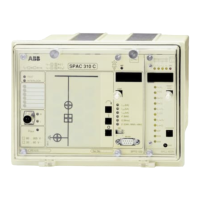18
Contact outputs
Control output numbers X0/65-66 and 85-86
- rated voltage 250 V ac or dc
- continuous carry 5 A
- make and carry for 0.5 s 30 A
- make and carry for 3 s 15 A
- breaking capacity for dc, when the control circuit
time constant L/R≤ 40 ms at the control voltage
levels 48/110/220 V dc 5 A/3 A/1 A
- contact surface AgCdO
2
- control output operating mode,
when operated by the control module pulse shaping
- control pulse length 0.1…100 s
Signalling output numbers X1/1-2-3, 4-5, 6-7 and 8-9
- rated voltage 250 V ac or dc
- continuous carry 5 A
- make and carry for 0.5 s 10 A
- make and carry for 3 s 8 A
- breaking capacity for dc, when the control circuit
time constant L/R≤ 40 ms at the control voltage
levels 48/110/220 V dc 1 A/0.25 A/0.15 A
- contact surface AgCdO
2
Auxiliary supply voltage
Type of built-in power supply module and
supply voltage range
- type SPGU 240 A1 80...265 V ac or dc
- type SPGU 48 B2 18...80 V dc
Burden of auxiliary supply under quiescent/
operating conditions ~10 W / ~15 W
Combined overcurrent and earth-fault module SPCJ 4D29
Low-set overcurrent stage I>
- current setting range 0.5…2.5 x I
n
- operation modes to be selected
- definite time operation
- operating time t> 0.05…300 s
- inverse definite minimum time (IDMT)
mode as per IEC 255-4 and BS 142 Extremely inverse
Very inverse
Normal inverse
Long time inverse
- special type inverse characteristics RI-type inverse
RXIDG-type inverse
- time multiplier k 0.05…1.0
High-set overcurrent stage I>>
- current setting range 0.5…40 x I
n
and ∞
- operating time t>> 0.04…300 s
Note!
The high-current end of any inverse time char-
acteristic is determined by the high-set stage
which, when started, inhibits the low-set stage
operation. The trip time is thus equal to the set
t>> for any current higher than I>>. In order to
get a trip signal, the stage I>> must be linked to
a trip output.

